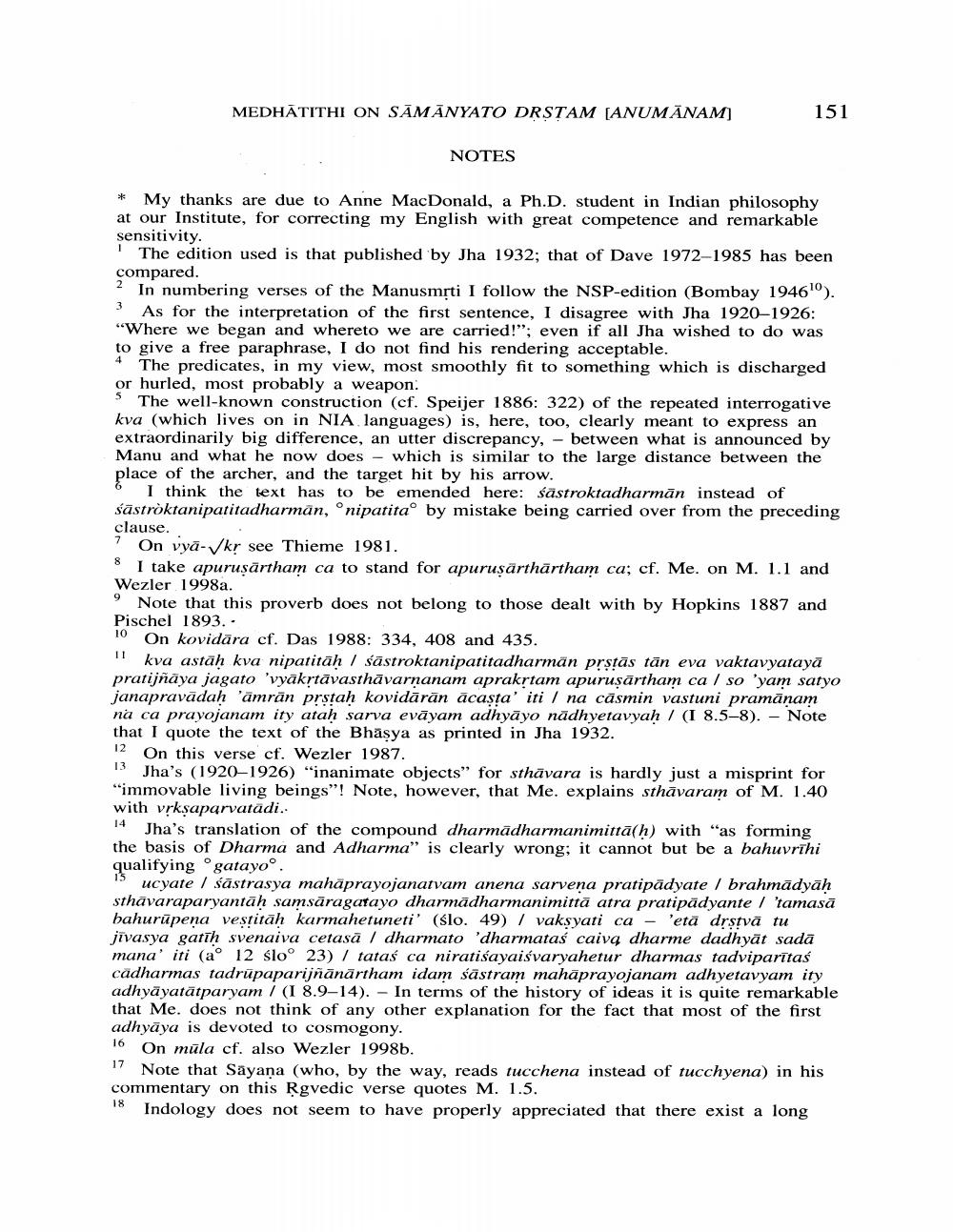________________
MEDHATITHI ON SĀMĀNYATO DRSTAM (ANUMĀNAM]
151
NOTES
* My thanks are due to Anne MacDonald, a Ph.D. student in Indian philosophy at our Institute, for correcting my English with great competence and remarkable sensitivity.
The edition used is that published by Jha 1932; that of Dave 1972-1985 has been compared 2 In numbering verses of the Manusmrti I follow the NSP-edition (Bombay 1946). 3 As for the interpretation of the first sentence, I disagree with Jha 1920-1926: "Where we began and whereto we are carried!"; even if all Jha wished to do was to give a free paraphrase, I do not find his rendering acceptable. 4 The predicates, in my view, most smoothly fit to something which is discharged or hurled, most probably a weapon. 3 The well-known construction (cf. Speijer 1886: 322) of the repeated interrogative kva (which lives on in NIA languages) is, here, too, clearly meant to express an extraordinarily big difference, an utter discrepancy, - between what is announced by Manu and what he now does – which is similar to the large distance between the place of the archer, and the target hit by his arrow.
I think the text has to be emended here: Sastroktadharmān instead of śāstroktanipatitadharman, onipatitao by mistake being carried over from the preceding clause. 7 On vyā- kr see Thieme 1981.
I take apurusärtham ca to stand for apurusärthärtham ca; cf. Me. on M. 1.1 and Wezler 1998a. 9 Note that this proverb does not belong to those dealt with by Hopkins 1887 and Pischel 1893.. 10 On kovidāra cf. Das 1988: 334, 408 and 435. "I kva astah kva nipatitäh / śāstroktanipatitadharmän prstäs tän eva vaktavyatayā pratijñāya jagato 'vyakştāvasthāvarnanam aprakrtam apuruṣārtham ca / so 'yam satyo janapravādah 'amrän prstah kovidārān acasta' iti / na cāsmin vastuni pramānam na ca prayojanam ity ataḥ sarva evāyam adhyāyo nādhyetavyah / (1 8.5-8). - Note that I quote the text of the Bhäsya as printed in Jha 1932. 12 On this verse cf. Wezler 1987. 13 Jha's (1920-1926) "inanimate objects" for sthāvara is hardly just a misprint for "immovable living beings"! Note, however, that Me. explains sthāvaram of M. 1.40 with vrksaparvatadi.. 14 Jha's translation of the compound dharmādharmanimittā(h) with "as forming the basis of Dharma and Adharma" is clearly wrong; it cannot but be a bahuvrihi qualifying gatayoo.
ucyate / śāstrasya mahäprayojanatvam anena sarvena pratipădyate / brahmădyah sthāvaraparyantah samsāragatayo dharmādharmanimittā atra pratipädyante / 'tamasā bahurūpena vestitäh karmahetuneti' (slo. 49) / vaksyati ca - 'etä drstva tu jīvasya gatih svenaiva cetasä / dharmato 'dharmatas caiva dharme dadhyāt sadā mana' iti (ao 12 sloo 23) / tataś ca niratiśayaišvaryahetur dharmas tadviparītas cadharmas tadrüpaparijnānārtham idam śāstram mahāprayojanam adhyetavyam ity adhyāyatātparyam / (1 8.9-14). - In terms of the history of ideas it is quite remarkable that Me. does not think of any other explanation for the fact that most of the first adhyāya is devoted to cosmogony. 16 On mūla cf. also Wezler 1998b. 17 Note that Sayana (who, by the way, reads tucchena instead of tucchyena) in his commentary on this Rgvedic verse quotes M. 1.5. 8 Indology does not seem to have properly appreciated that there exist a long




